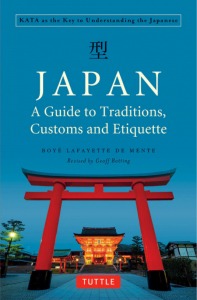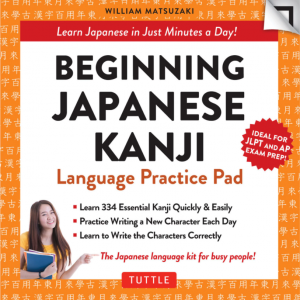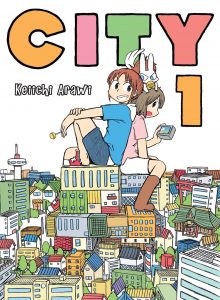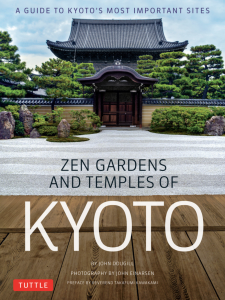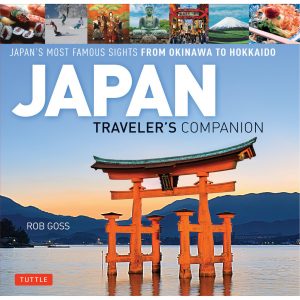JQ Magazine: Book Review — New from Tuttle (Spring 2018)
By Rashaad Jorden (Yamagata–ken, 2008-10) for JQ magazine. A former head of the JETAA Philadelphia Sub–Chapter, Rashaad is a graduate of Leeds Beckett University with a master’s degree in responsible tourism management. For more on his life abroad and enthusiasm for taiko drumming, visit his blog at www.gettingpounded.wordpress.com.
Tuttle Publishing has released another selection of Japan-related books, and the following quartet includes works that touch on Japanese etiquette, language study, Okinawan history, and picturesque Kyoto.
Japan: A Guide to Traditions, Customs and Etiquette
While studying Japanese, I learned the term shikata, which is translated as the “way of doing things.” However, as the late lecturer and writer Boyé Lafayette de Mente thoroughly documents, kata represents a lot more than a translation of “form”: It is a concept present in just about every aspect of Japanese society, whether it be the business world, poetry, or sumo. In essence, kata guides the country’s etiquette.
In Japan, the process of accomplishing a goal is just as significant, if not more significant, than the actual result—a notable contrast to the West. De Mente defines kata as the “way things are supposed to be done,” and he educates readers on how the concept has shaped Japan throughout its history and the present.
The author also touches on other cultural differences between Westerners and Japanese (such as communication styles) and people reading the book will probably nod their heads in agreement as they read certain passages, such as “Foreigners can live a lifetime in Japan and not fully understand how the Japanese system works the way it does” and why Japanese often express amazement at foreigners who can utter the simplest Japanese phrase. Japan: A Guide to Traditions, Customs and Etiquette is really an exploration of the Japanese psyche.
If nothing else, you’ll be amazing at how different Japan seems from the West.
Beginning Japanese Kanji: Language Practice Pad
Those seeking an introduction to kanji, or just a way to brush up on them, should turn to William Matsuzaki’s work. The pad is an excellent tool for busy people: The 334 kanji it presents lends itself to a simple, one kanji-a-day memorization for those aiming to study at a relaxed pace. Furthermore, each page contains terms utilizing the featured kanji and tips on how to write its strokes.
The kanji appearing in the pad is really nothing out of the ordinary, as you’ll see them in many (if not most) materials geared toward relatively novice Japanese learners. Adding to the book’s appeal, the inclusion of spaces to write the kanji (as well as sample sentences featuring the characters) is most useful for those looking to bolster their knowledge of the language.
JQ Magazine: Manga Review — ‘CITY’
By Rashaad Jorden (Yamagata–ken, 2008-10) for JQ magazine. A former head of the JETAA Philadelphia Sub–Chapter, Rashaad is a graduate of Leeds Beckett University with a master’s degree in responsible tourism management. For more on his life abroad and enthusiasm for taiko drumming, visit his blog at www.gettingpounded.wordpress.com.
Work often gets in the way of fun times. But if you incorporate some creativity into your life, that doesn’t have to be the case.
Enter the world of Midori Nagumo, the protagonist of the comedy manga CITY. In this first volume (which began serialization in Japan in September 2016) from creator Keiichi Arawi (Nichijou), Nagumo is a very broke college student whose landlady is constantly hounding her for money. Her roommate Niikura refuses to lend her money when she realizes what Nagumo’s true intention is.
Nagumo has to resort to other avenues to raise money, such as stealing a clay figure with the aim of selling it. But she clumsily drops the object, rendering it shattered. Crazily enough, immediately afterwards she’s offered a job at a restaurant (where the incident happens).
Our protagonist accepts the job but still has issues. It doesn’t help that her landlady has a police officer help “move” (or steal) all of her stuff so she wouldn’t escape (as the stolen items are actually collateral). In the middle of the volume, Nagumo reflects on her life, telling herself that if she could continue to have lots of happy moments, she’d be unbelievably thrilled with her life.
JQ Magazine: Book Review — ‘Zen Gardens and Temples of Kyoto’
By Rashaad Jorden (Yamagata–ken, 2008-10) for JQ magazine. A former head of the JETAA Philadelphia Sub–Chapter, Rashaad is a graduate of Leeds Beckett University with a master’s degree in responsible tourism management. For more on his life abroad and enthusiasm for taiko drumming, visit his blog at www.gettingpounded.wordpress.com.
Kyoto has served as the focal point of Japanese cultural forms such as geisha, noh theater and ikebana. And as John Dougill thoroughly details in Zen Gardens and Temples of Kyoto, the city has played an enormous role in the development of Zen in Japan.
A professor at Kyoto’s largest Buddhist university, Dougill explores the ties between Japan’s former capital and the Buddhist sect in this guide to Kyoto’s most prominent Zen gardens and temple sites. While not the birthplace of Zen in Japan, Kyoto could be considered its soul as the city has long housed renowned temples where visitors and monks have sought serenity.
At first glance, such a book would seem to be a largely visual journal featuring a score of beautiful places. Zen Gardens doesn’t disappoint in that regard as photographer John Einarsen captures the splendor of some very spiritual places. But it’s clear early on that the book will rely primarily on stories to chronicle the story of Zen in Kyoto—not surprising since Dougill has previously written about Japan’s World Heritage Sites and Kyoto’s history.
JQ Magazine: Book Review — ‘The JET Program and the US-Japan Relationship: Goodwill Goldmine’
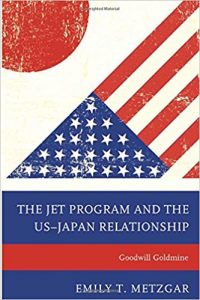
“While focused solely on the American experience, the outline of the history and intention behind the JET Program’s creation is a fascinating and illuminating one. One hopes that this book will be the start of the conversation and academic study on JET’s other accomplishments and help complete the picture of a fallible but venerable institution.” (Lexington Books)
By Eden Law (Fukushima-ken, 2010-11) for JQ magazine. Eden is the current JETAA New South Wales President (in Sydney, Australia) and Australian JET Alumni Association Country Representative, and handles the social media/website side for JETAA International as Webmaster. He also runs the Life After JET podcast.
Note: Spelling is always problematic when dealing with international differences. I shall be spelling “Program” the way it is referred to in the book and the title, to avoid inconsistencies. Apologies, especially to any fellow Australians reading this. However, I’ll be keeping my quixotically placed “u”s and “r”s.
Created in 1987, The JET Program has brought tens of thousands of young people from around the world to work, live and experience life in Japan. An international exchange program of a diplomatic nature, its aims were to improve global perceptions towards Japan and to internationalised Japanese local communities, all through the format of teaching and improving English skills in schools. Since then, articles and papers about the effectiveness of JET has focused primarily on its impact (or lack thereof) on the level of English language ability on the student population, leading to questions about the feasibility of maintaining the high costs of the program. At least once, the program came close to termination: In 2010, a Japanese government budget review panel called for the discontinuation of JET, before the subsequent administration of Shinzo Abe saved it, setting the agenda for expanding numbers in the lead-up to the 2019 Rugby World Cup and the 2020 Tokyo Olympics.
More positive literature exists, of course: David L. McConnell’s Importing Diversity: Inside Japan’s JET Program, published in 2000, is the most well-known example, written by an academic who was once a JET participant. Seventeen years on, Emily T. Metzgar (Shimane–ken, 1993-95), herself also once a JET and now an academic, has penned a follow-up of sorts, entitled The JET Program and the US-Japan Relationship: Goodwill Goldmine, which, as described in its title, confines its evaluation of the program on its international impact in relation to the United States and Japan. The JET Program justifies its restricted focus on this bilateral relationship on its assertion that the program was originally created with the United States in mind as the first target for Japan to improve its international image abroad. Statistically, 50 percent of the total number of participants throughout the program’s history have been sourced from the United States (and in an impeccable sense of timing, the book arrived on the eve of the program’s big 30th anniversary celebrations and JETAA conference in Washington, D.C., featuring Metzgar as one of the headline presenters).
Commentators seeking to put a more positive outlook on the program’s accomplishments have had to look outside of the hoary old topic of education. The JET Program settles on examining how it worked as a “soft power” initiative for Japan’s global image (the topic of how JET fared as an internationalisation agent of Japanese local community is, as Metzgar says, best left “as a promising research topic for an ambitious doctoral student,” though she does comment on these other aims later on). For those wondering, yes, the book argues that JET has been enormously successful in this aspect. Examples are plentiful in The JET Program: recalling the threat of JET’s culling high-profile American JET alumni in organisations such as the American Enterprise Institute (AEI) and JCIE/USA defended it by referring to its “soft power” success. In other less fraught periods, the book cites senior members and policymakers of both governments who spoke positively of JET’s contributions to their countries’ relationship, implying acknowledgement of the same thing.
JQ Magazine: Book Review — ‘The Abundance of Less’

“Although the purpose of The Abundance of Less might be to extol the virtues of simple living, it emerges as an enriching journey into the world of many extraordinary people.” (North Atlantic Books)
By Rashaad Jorden (Yamagata–ken, 2008-10) for JQ magazine. A former head of the JETAA Philadelphia Sub–Chapter, Rashaad is a graduate of Leeds Beckett University with a master’s degree in responsible tourism management. For more on his life abroad and enthusiasm for taiko drumming, visit his blog at www.gettingpounded.wordpress.com.
Simple living. Sustainability. Living off the grid. Practices and ideals that could bring about an enriching life and possibly freedom for many people—as well as concepts that have become more prevalent in recent years.
But the above-mentioned buzzwords aren’t endemic to the West. Thanks to Andy Couturier, the stories of Japanese living the most sustainable lives they can outside of the mainstream is documented in The Abundance of Less: Lessons in Simple Living from Rural Japan.
Couturier, a former English teacher and staff writer for the Japan Times, originally profiled ten Japanese living “a very principled way of life” that didn’t feed the capitalist machine for his 2010 book A Different Kind of Luxury. Spurred on by a surge in environmental activism following the nuclear meltdown in Fukushima, the author provides updates on each of the people he profiled in his original book (unfortunately, two of them have since passed away).
The people providing the “lessons” are (or have been), among other things, an anarchist; a writer/filmmaker inspired by the hippie counterculture; and a painter. Couturier was introduced to several of the ten people he wrote about by Atsuko and Gufu Watanabe, a couple he and his partner Cynthia met while teaching in Japan. Although the bookends of The Abundance of Less are dominated by his observations about life in Japan, a how-to guide for those wanting to follow in his footsteps (Couturier and his partner built their abode in California by themselves and applied many of the principles they learned in Japan) and his life story, the book largely focuses on the remarkable individuals he profiles.
JQ Magazine: Book Review — ‘Speak and Read Japanese’

“Speak and Read Japanese won’t be mistaken for the most thorough guide for learning the language. But it is a nice reminder that injecting humor into language learning can go a long way.” (Stone Bridge Press)
By Rashaad Jorden (Yamagata–ken, 2008-10) for JQ magazine. A former head of the JETAA Philadelphia Sub–Chapter, Rashaad is a graduate of Leeds Beckett University with a master’s degree in responsible tourism management. For more on his life abroad and enthusiasm for taiko drumming, visit his blog at www.gettingpounded.wordpress.com.
Your JET experience (hopefully) included a lot of Japanese study. Whether you remember what learned is another story. But it might have helped to concoct some humorous words and phrases to help you best retain the new vocabulary.
Enter the world of mnemonics, courtesy of author Larry Herzberg. The longtime professor has created a language guide titled Speak and Read Japanese: Fun Mnemonic Devices for Remembering Japanese Words and Their Meanings.
You might be wondering, just what are mnemonics? They’re tools language learners might find indispensable in preventing the meanings of new words from escaping their minds. Early in Speak and Read Japanese, Herzberg mentions that such memory hooks have served as the best method of learning new vocabulary in foreign languages for him, for if he could tie the sound of words he was trying to learn to a word in English, he was more likely to retain the new vocabulary.
So is Herzberg’s work a productive tool for language learners? Well, much of the book is an English-Japanese dictionary featuring the translation of many common words and better yet (for hardcore Japanese learners), detailed breakdowns of each word’s kanji as well as literal translations for some terms. You might not have known that hikouki (airplane) is literally translated as “flying-going machine” and shinshitsu (bedroom) means “sleeping room.” And those wanting to improve writing kanji will be pleased to discover a chart of radicals toward the end of the book.
JQ Magazine: Book Review — New from Tuttle (Fall 2017)
By Rashaad Jorden (Yamagata–ken, 2008-10) for JQ magazine. A former head of the JETAA Philadelphia Sub–Chapter, Rashaad is a graduate of Leeds Beckett University with a master’s degree in responsible tourism management. For more on his life abroad and enthusiasm for taiko drumming, visit his blog at www.gettingpounded.wordpress.com.
Tuttle Publishing has released a selection of four books touching on subjects such as otaku culture, language/cultural tips for travelers, Japanese history, and inspiration for prospective visitors to Japan.
Many people have probably developed an interest in Japan through a deep affection for anime and manga (among other things). And with Tokyo being the obvious center of Japanese pop culture, this guide created by Gianni Simone serves as the perfect tool for otaku freaks to find heaven.
Tokyo Geek’s Guide basically resembles a travel guide as it contains tidbits about where to explore otaku culture (such as bookshops, stores, events and even eateries—anime-themed ones are abundant in Tokyo). But you don’t have to be planning a trip to the capital to benefit from the book, though. Simone includes plenty of information pertaining to the history of manga, anime and video games in Japan.
Japanese for Travelers Phrasebook & Dictionary
At first glance, Scott Rutherford’s creation seems like a carbon copy of any other resource geared toward helping travelers avoid or limit communication miscues. And certainly, the book lists the standard customary helpful phrases for visitors to Japan trying to navigate the local hotels, airports, restaurants, etc.
But Japanese for Travelers provides plenty of useful advice about conducting good Japanese etiquette (e.g., what to do when invited to someone’s house) and culture (the section devoted to Japanese naming culture is interesting). Although the guide doesn’t intend to be the most thorough tool for language learners, it does include an English-Japanese glossary and numerous grammatical tips. And perhaps most importantly in this technologically reliant time, Rutherford dedicates a chapter to advising readers about how not to get tripped up by technology in Japan.
To many, the title of Jonathan Clements’s work would seem to be an absolute impossibility. Indeed, he uses that word in the preface to describe his task in telling a story that spans “millions of years.” But Clements settles on “specific moments of transformation” in eleven chapters that address periods of Japanese history ranging from the legend behind Japan’s formation to the “lost decades” that saw the country face a dwindling population and struggling economy.
While the information Clements provides at some points may be overwhelming, A Brief History of Japan does come to life through the collection of images appearing in the middle of the book (such as depictions of prominent figures and photos of landmarks).
Many, if not most, travel guides will feature an endless parade of “what to do and see” recommendations, and Rob Goss’s work is no different in a sense. But unlike some editions of Lonely Planet and Fodor’s, it’s clear when opening up Japan: Traveler’s Companion for the first time that the book will be anything but dry.
The subtitle appearing on its cover is “Japan’s most famous sights from Okinawa to Hokkaido,” but the inclusion of popular tourist destinations isn’t the reason to pick up the book. Amazingly beautiful colorful photos of the country’s most famous places will leave you speechless, and Goss includes helpful information for potential visitors about facets of Japanese life such as matsuri, cutting edge technology, and tradition.
For more information, visit www.tuttlepublishing.com.
For more JQ magazine book reviews, click here.
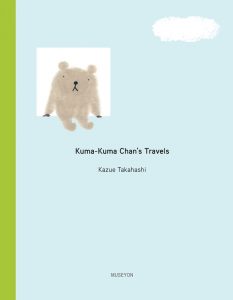
“Takahashi’s warm watercolors and relatable stories are guaranteed to entertain readers of all ages, and the latest English-language addition to this series, Kuma-Kuma Chan’s Travels, is every bit as enjoyable as its two predecessors.” (Museyon)
By Stacy Smith (Kumamoto-ken CIR, 2000-03) for JQ magazine. Stacy is a New York City–based provider of top quality Japanese interpreting, translating and writing/editing services. Starting from her initial encounter with Japan in her teens, she has built up a consummate understanding of the country‘s language and culture, enabling her to seamlessly traverse between Japan and the U.S. and serve as a bridge between the two. For more information, visit www.stacysmith.webs.com. As a writer, Stacy also shares tidbits and trends with her own observations in the periodic series WIT Life.
Having spent three years on JET in Kumamoto, home of nationwide sensation Kumamon who didn’t yet exist when I was there, I must honestly say that I approach bear characters with slight trepidation. However, I was delightfully surprised to love every minute of my encounter with Kuma-Kuma Chan, the bear who stars in the eponymous children’s book series written and illustrated by Kazue Takahashi. Her warm watercolors and relatable stories are guaranteed to entertain readers of all ages, and the latest English-language addition to this series, Kuma-Kuma Chan’s Travels, is every bit as enjoyable as its two predecessors.
The previous two books, Kuma-Kuma Chan, the Little Bear (previously reviewed in JQ here) and Kuma-Kuma Chan’s Home, looked at a day in the life of Kuma-Kuma Chan on his own and when a friend comes to visit. Kuma–Kuma Chan’s Travels is a bit more expansive, introducing readers to his world when he takes trips. I love the details at the beginning sharing what he brings with him on his journeys, along with accompanying illustrations such as a Thermos containing hot coffee. We later see him on top of a mountain drinking said coffee while watching the sunrise. These trips take place inside his head, but the descriptive text and beautiful pictures make you feel like you are with him everywhere he goes.
The series as a whole features a strong element of kawaii, or cuteness, which contributes to its Japaneseness. Also, there is an intangible sensibility to the stories that make them feel a bit different than traditional Western children’s books. In the inaugural Kuma–Kuma Chan, the Little Bear, we learn about his daily routine, which includes aspects such as eating a big salad for breakfast with lettuce from his garden and personal grooming like trimming his nails and hair. I particularly liked the scene which shows him during the winter, rolling around to catch the sunlight as the day progresses with the kerosene heater nearby. For many JET alumni, I’m sure this scene will be reminiscent of days spent in school offices where this was the sole source of heat.
For readers seeking a creature of a different nature, the Tyrannosaurus children’s books written and illustrated by Tatsuya Miyanishi is another series worth checking out. It currently features 13 titles, four of which have been published in the U.S. For those who would like to learn about these books and meet the acclaimed author, he will be at the New York and New Jersey locations of Books Kinokuniya at 2 p.m. on October 21 and 22, respectively. On both days, Miyanishi will be reading from and discussing his works, as well as signing books for those with purchased copies. For more dates in Texas, Washington and California, click here.
Kuma-Kuma Chan’s Travels is available October 1. For more information, click here.
For more JQ magazine book reviews, click here.
JQ Magazine: Manga Review — ‘She and Her Cat’ and ‘Mobile Suit Gundam Wing: Endless Waltz — Glory of the Losers’

“In She and Her Cat, Shinkai does what he does best, using carefully curated imagery to set a somber tone that soothes readers into a quiet, meditative headspace.” (Vertical Comics)
By Preston Hatfield (Yamanashi–ken, 2009-10) for JQ magazine. Preston received a BA in English literature with an emphasis in creative writing and a minor in Japanese at the University of California, Davis. After spending an amazing year on JET in Yamanashi, he spent a year writing and interning with book publishing companies in New York. He currently lives in Cupertino, where he continues to cover local Japan–related stories for JQ.
This season, Vertical Comics releases two notable titles. The first is She and Her Cat, a story by acclaimed animator Makoto Shinkai, the mastermind behind 5 Centimeters Per Second and Your Name. The second is Mobile Suit Gundam Wing: Endless Waltz — Glory of the Losers, a multi-volume adventure starring everyone’s favorite fighting mecha. While very different in style, pacing, and subject matter, each title has a lot to offer its readers.
In She and Her Cat, Shinkai does what he does best, using carefully curated imagery to set a somber tone that soothes readers into a quiet, meditative headspace. From there he proceeds to unfold an understated vignette that explores adult depression. This is a timely story, our considering society’s gradual willingness to speak openly about depression and mental health more broadly.
Shinkai’s protagonist, Miyu, is a sympathetic introvert who has a hard time asking for or accepting help from others, and she is also her own antagonist, a fact that will likely resonate with readers who have battled depression. One unique feature about this story, which is also at times strained, is that it is told from the perspective of the protagonist’s cat, Chobi. While some readers may feel that Shinkai could have done more with this story, it is nonetheless well told and tactfully, intelligently handled.
By contrast, Glory of the Losers delivers action, explosions, and braggadocio. Based on creator Yoshiyuki Tomino’s classic 1970s giant robot series, the story follows a common trope: In a post-apocalyptic world, humans have broken off into different factions to colonize other planets. But when a central military agency begins annexing free colonies, a small resistance rises in the name of freedom to end their tyranny. This is an enjoyable underdog story that may have particular appeal to middle and high school students.
For more information, visit www.vertical-inc.com.
JQ Magazine: Book Review — ‘The Seed of Hope in the Heart’

Although The Seed of Hope is a memoir of one man’s experiences during a challenging period in recent Japanese history, it is also a fascinating look into how the people of Tohoku struggled but fought to rebuild their lives. (Amazon Digital Services LLC)
By Rashaad Jorden (Yamagata–ken, 2008-10) for JQ magazine. A former head of the JETAA Philadelphia Sub–Chapter, Rashaad is a graduate of Leeds Beckett University with a master’s degree in responsible tourism management. For more on his life abroad and enthusiasm for taiko drumming, visit his blog at www.gettingpounded.wordpress.com.
There are certain moments we remember clearly as if they happened only yesterday, whether they are monumental historical events or natural disasters. But how would you tell stories centering on those moments?
Teiichi Sato has a go at it in The Seed of Hope in the Heart. In the memoir, Sato, an Iwate Prefecture seed shop owner, survives the 2011 Tohoku earthquake and tsunami but sees his beloved seed shop crumble. This plunges him into the task of rebuilding his life and livelihood amidst destruction while trying not to sink into depression and despair.
It all started with the disaster that struck on March 11, which didn’t actually come out of the blue. Sato explains that after a strong earthquake hit the Kesen area two days prior, a tsunami advisory was issued, which wasn’t really cause for a cause for concern as “weak” tsunami advisories were frequent around Rikuzentaka (where Sato lived).
But obviously, it should have been as for much of Tohoku, the world changed starting on 2:46 p.m. on March 11. Sato spends much of the early chapters detailing not only his perspective of the earthquake, but more dramatically his escape from the oncoming tsunami. While reading The Seed of Hope, you get the sense of being transported into a movie as it contains no shortage of drama as Rikuzentaka’s citizens make a desperate dash to find shelter—some of whom aren’t able to do so successfully.
JQ Magazine: Manga Review — ‘Kitaro and the Great Tanuki War’

“The Great Tanuki War stands apart from the other Kitaro volumes because in this adventure, the stakes are higher than anything you’ve ever seen.” (Drawn and Quarterly)
By Julio Perez Jr. (Kyoto-shi, 2011-13) for JQ magazine. A bibliophile, writer, translator, and graduate from Columbia University, Julio currently keeps the lights on by working at JTB USA while writing freelance in New York. Follow his enthusiasm for Japan, literature, and comic books on his blog and Twitter @brittlejules.
A haunted house built on an ancient burial ground? That’s minor league. How about an entire nation built above an army of human-hating yokai who command a catfish large enough to cause earthquakes?
Shigeru Mizuki’s Kitaro and The Great Tanuki War is a manga volume that tells an epic tale pitting the titular character, Kitaro, against an army of tanuki and their powerful yokai allies. There are also a few bonus stories with Kitaro’s usual one-shot adventures. You may already be familiar with Mizuki’s famous character, but if you are not, you can brush up on his origin story featured in the first volume, The Birth of Kitaro, which JQ reviewed last year here.
This marks the third volume in the English collection of Kitaro stories published by the fine folks at Drawn and Quarterly. One of our very own JET alums, Zack Davisson (Nara-ken, 2001-04; Osaka-shi, 2004-06), has been doing his part to put Shigeru Mizuki’s timeless work on the map in the English-speaking world. He has served as translator for these Kitaro stories and also for Mizuki’s colossal four-volume manga history of the Showa period. Zack is a yokai expert in his own right and you can find out more about his career and JET experience in our vintage JQ interview with him.
As many consumers of Japanese media may already be aware, yokai are strange creatures or phenomena that originate in Japan and have become widely popular globally. Kitaro is a unique yokai who solves mysteries and fights for humans. The conflict between humans and yokai is often an issue of tension for him as he straddles both sides, but this conflict takes center stage in The Great Tanuki War, when an army of tanuki escape from their underground dwelling beneath the island of Shikoku (shout-out to our Shikoku JET alums!), to wage a war on the human residents of Japan.
JQ Magazine: Book Review — ‘25 Places in Canada Every Family Should Visit’

“This year marks Canada’s 150th anniversary, so it’s a wonderful time for families to explore the wonders of the country. You just need the right information to do so, and 25 Places serves as a worthy reference guide.” (TouchWood Editions)
By Rashaad Jorden (Yamagata–ken, 2008-10) for JQ magazine. A former head of the JETAA Philadelphia Sub–Chapter, Rashaad is a graduate of Leeds Beckett University with a master’s degree in responsible tourism management. For more on his life abroad and enthusiasm for taiko drumming, visit his blog at www.gettingpounded.wordpress.com.
Summer is almost here. With the kids out of school, it’s the perfect time to explore new places and travel as a family. But where should you go?
Those thinking about Canada should seek out Jody Robbins’ 25 Places in Canada Every Family Should Visit for ideas. Robbins, a JET alum (Tottori-ken, 1994-97) and arguably one of Canada’s most prominent travel writers, profiles locations going counterclockwise from Victoria to Yukon, from the famous (Toronto, Vancouver) to the relatively unknown (Parksville-Qualicum Beach, Avalon Peninsula).
As the book is geared towards parents, Robbins devotes plenty of space to sharing advice about how they can entertain their young ones. In addition to expounding on the requisite what to do and see activities for each destination, Robbins just as importantly lists family-friendly options for dining (“Kids will love the wood-fired bambino pizza” at Pizzeria Prima Strada in Victoria) and lodging (a highlight of the Fairmount Chateau Laurier in Ottawa is the Art Deco-style pool, which “children love parading down to in their child-size bathrobes”).
25 Places features a diverse mix of urban and nature-filled destinations (like Outaouauis), so readers will get a great sense of Canada’s varied landscapes, as well as some surprises (beaches on the Prairies? Yes, they exist) and more importantly, how to arrive prepared for them. While it’s obvious that Robbins would include information about how to get around certain places, she excels when extensively detailing how to make your camping trip a safe and wonderful experience: An entire chapter is devoted to providing readers advice about tackling and overcoming the challenges that awaits (as well as tips about what to pack and eat). Camping novices would do well to heed this helpful advice.
JQ Magazine: Book Review — ‘The Little Exile’
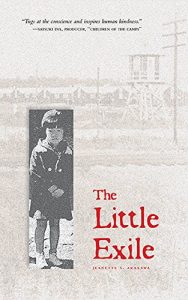
“The Little Exile reveals a world of angst, but hope in a world that has been turned upside down.” (Stone Bridge Press)
By Rashaad Jorden (Yamagata-ken, 2008-10) for JQ magazine. A former head of the JETAA Philadelphia Sub-Chapter, Rashaad is a graduate of Leeds Beckett University with a master’s degree in responsible tourism management. For more on his life abroad and enthusiasm for taiko drumming, visit his blog at www.gettingpounded.wordpress.com.
Earlier this year I explored Uprooted, an exhibition devoted to the Japanese American internment. Considering how many families were displaced following Pearl Harbor, “uprooted” is at the perfect word to describe how a lot of people’s lives were disrupted.
Uprooted also comes to mind when reading The Little Exile. Written by Jeanette Arakawa, the novel tells the story of Marie Mitsui, a Japanese American girl living in San Francisco, whose world is jolted after the events of December 7, 1941 as she and her family is forced to relocate to an internment camp in Arkansas. Based on her own life story (although some names in the book have been changed), Arakawa takes readers on a journey through the brutal challenges that many Japanese Americans faced.
At first, you might think that The Little Exile is an uneventful novel, as the first few chapters capture a seemingly carefree life that the Mitsuis enjoy (Marie has an older brother named Brian). They seem to be a typical American family—Marie’s parents run a dry cleaning shop where the whole family lives. She loves roller-skating with her friend Beverly and often spends time on the playground (She frequently wins amateur hour contests there).
However, San Francisco is not paradise for the Mitsuis—Brian learns from his father that due to “racial covenants,” the family is prohibited from buying houses in a certain neighborhood. In addition, classmates hurl racial slurs at Brian and Marie upon their arrival at the Lawton School in December 1940.
JQ Magazine: Book Review — ‘Japanese Garden Notes’

Keane is the perfect person to expound on the finer aspects of the Japanese garden. Reading Japanese Garden Notes basically transports you to a museum as the text is similar to the interpretation you’d receive from a seasoned docent. (Stone Bridge Press)
By Rashaad Jorden (Yamagata-ken, 2008-10) for JQ magazine. A former head of the JETAA Philadelphia Sub–Chapter, Rashaad is a graduate of Leeds Beckett University with a master’s degree in responsible tourism management. For more on his life abroad and enthusiasm for taiko drumming, visit his blog at www.gettingpounded.wordpress.com.
One Golden Week afternoon after exploring Okayama Castle, I decided to stroll over to nearby Kōraku-en Garden. Mainly because it was there and I wasn’t sure what else to do in Okayama. But once I stepped on the premises of the garden, a sense of serenity fell over me as did the feeling I felt like I had found a gem, as well as a place where time stood still.
What is the world of these elegant locales like? Landscape architect and author Marc Peter Keane answers that question and more in Japanese Garden Notes: A Visual Guide to Elements and Design.
It’s clear that Keane, a garden designer and Kyoto resident for roughly twenty years, will explain “what makes a Japanese garden feel the way it does” largely through photographs. But what will readers be looking at? Pretty much Japanese Gardens 101, as each chapter bears the name of a concept or feature present in Japanese gardens like meandering paths, arbor bridges, streams, and more. A phrase further describing the main concept appears prior to the explanations in each chapter and those descriptions run the gamut from the profound (“A meandering path is full of surprises”) to the explanatory regarding the appearance of the garden (“Linking a distant part of the garden with the foreground”) to the borderline hilarious (“Japan is wet, thus the dry garden.”).
Hey JET alum parents! Discover Canada with your kids!
Jody Robbins, a Tottori ALT from 1994-1997, has just written her first book! Published in May, 2016. 25 Places in Canada Every Family Should Visit is the ultimate guide to family travel in the Great White North. This year Canada celebrates its 150th year. From coast to coast, north to south, the country will be aflutter with events and celebrations, making 2017 the best time to discover Canada with your family.
Families have different travel needs, and Robbins gives the scoop on affordable hotels, worth-it attractions and nature hideaways, in addition to piquing the interest of young travellers with quirky, kid-friendly facts. Catering to families such as her own, she’s pulled together 25 of Canada’s best family-friendly destinations and compiled in-depth profiles for each, providing more than a few ideas to keep even the most active of families busy.
She also offers loads of how-to advice to make family travel a more pleasant experience. Robbins reveals how creativity and managing expectations go a long way to rekindling romance, offers practical advice on how to see the world for less and dishes on how to survive long road trips.
You can support this alumnus by ordering her book online (it makes a great gift!) or sharing the word with your friends.
And please visit Jody’s blog Travels with Baggage for lifestyle tips and inspiration.

